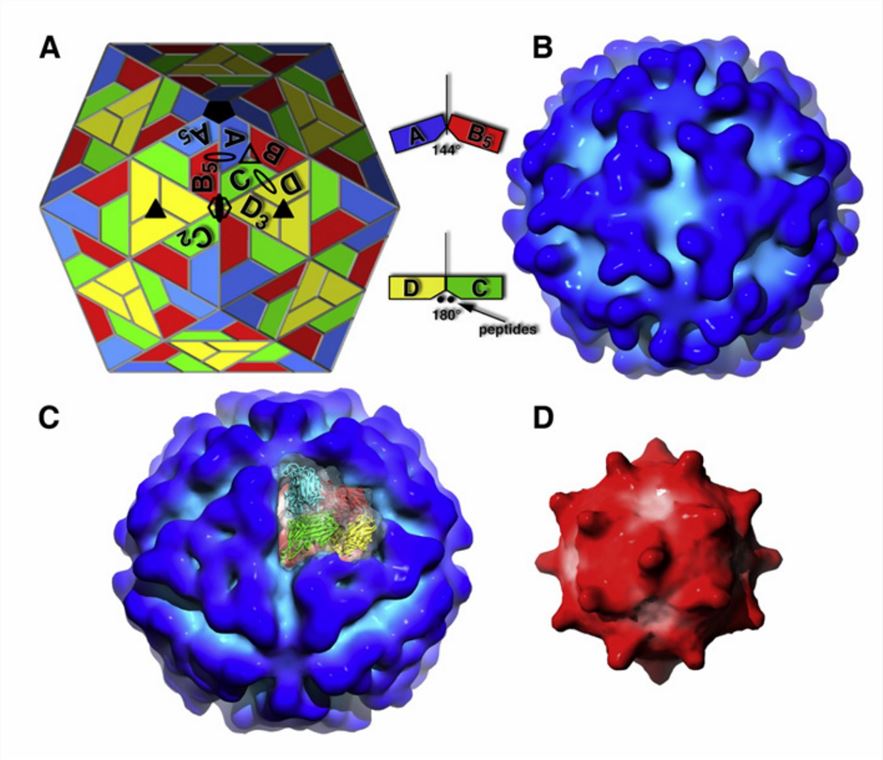Structural Research of Carmotetraviridae
Carmotetraviridae has only one genus, Alphacarmotetravirus, and only one species in that genus, the type species Providence virus (PrV). The PrV is a small, unenveloped insect RNA virus originally isolated from a persistently infected midgut cell line of the corn earworm, Helicoverpa zea (H. zea), and to date is the only tetravirus known to replicate in cell cultures. Like the other tetraviruses, PrV is thought to infect a narrow host range, limited to lepidopteran species. However, in recent research, PrV has been shown to infect and persistently replicate in human cervical cancer (HeLa) cell lines. To further explore the potential value of PrV, researchers generated virus-like particles (VLPs) of PrV in a recombinant baculovirus expression system, obtained high VLP yields, and determined the structure of PrV by cryo-electron microscopy (cryo-EM). The results promote the possibility of transferring non-infectious viruses to new hosts in the laboratory.
 Figure 1. Cyro-electron microscopy reconstruction of Providence virus. (Speir JA, et al., 2010)
Figure 1. Cyro-electron microscopy reconstruction of Providence virus. (Speir JA, et al., 2010)
Structural Features of PrV
PrV particles exhibit a typical conserved T = 4 tetraviral capsid structure, which is an isometric particle composed of two structural proteins (60 and 7.4 kDa) encapsidating genomic (6.4 kb) and subgenomic (2.5 kb) RNAs. All tetraviruses have either a single-part or a two-part (+) ssRNA genome encoding the viral replicase (REP) and a single capsid protein (CP) precursor, 240 copies of which are assembled into a capsid that is automatically cleaved during particle maturation. In addition to REP and CP, PrV encodes a large ORF (p130) that overlaps with the REP ORF. Unlike other tetraviruses with α-like or picorna-like replicases, PrV has a carmo-like viral replicase.
Analysis of the PrV Genome Structure
PrV has a 6.4-kb single-part genome encoding three ORFs, with a non-structural protein (p130) at the 5' end, which overlaps almost completely with the p130 ORF. Almost completely overlapping with the p130 ORF is the carmo-like viral replicase p104. The PrV replicase ORF encodes a type 1 read-through stop codon, the activity of which results in the translation of the truncated 40 kDa accessory protein p40. At the 3' end of the viral genome, an ORF, p81, translated from 2.5 kb of subgenomic RNA, encodes the viral capsid protein precursor. The p81 ORF encodes two active 2A-like processing sites at the N-terminal end, which result in translation products of 7, 8, and 68 kDa. The viral CP is assembled from p68, which is cleaved by autoproteolytic hydrolysis during particle maturation to β and γ peptides of 60 and 7.4 kDa, respectively.
Creative Biostructure, the world's leading provider of virus-like particles (VLPs), offers virus-like particle construction services and a wide range of VLP products. VLP is non-infectious and therefore does not require stringent biosafety levels of natural viruses, but retains the ability to self-assemble and present antigens for innovative therapeutic uses. As a result, our VLP products are increasingly used in vaccine development and have other essential applications in biotechnology, including as virus-like vectors for gene therapy, antibody screening, immunogen production, and ligand binding assays.
| Cat No. | Product Name | Virus Name | Source | Composition |
| CBS-V726 | Providence Virus VLP (Coat Protein) | Providence virus | Insect cell recombinant | Coat protein |
| Explore All Carmotetraviridae Virus-like Particle Products | ||||
Creative Biostructure has developed Mempro™ plant virus-like particle production technology for the efficient preparation of VLPs, as well as a range of VLP characterization approaches, such as SRID, HA assays, DLS, and AFFFF-MALS, to ensure optimal VLP services and products.
In addition, using cryo-electron microscopy (cryo-EM), a perfect visualization tool, our scientists can obtain images of virus particles in a near-natural state to characterize their physical properties, including shape, particle integrity, and aggregation. If you have requirements for viral structure research, please contact us for a comprehensive range of VLP products and tailored viral structure resolution services.
References
- Speir JA, et al. Evolution in action: N and C termini of subunits in related T = 4 viruses exchange roles as molecular switches. Structure. 2010. 18(6): 700-709.
- Jiwaji M, et al. Expanding the host range of small insect RNA viruses: Providence virus (Carmotetraviridae) infects and replicates in a human tissue culture cell line. J Gen Virol. 2016. 97(10): 2763-2768.
- Jiwaji M, et al. Providence virus: An animal virus that replicates in plants or a plant virus that infects and replicates in animal cells? PLoS One. 2019. 14(6): e0217494.